Have you ever impulsively bought something on Instagram or TikTok? Or been stalked by a couch you clicked on your social media?
Shopping now happens with a scroll and a click, with nearly one-third of young adults buying directly through social media. Social commerce is reimagining the traditional storefront, bringing it directly to our fingertips.
Learn what social commerce is, some examples of paid social media ads, the top platforms for social commerce, and explore strategies and examples to inspire your campaigns.
What is Social Commerce?
Social commerce lets people buy and sell directly on social media platforms. It goes beyond just discovering products—users can complete the entire purchase in-app, from browsing to checkout, without switching to a separate site.
Platforms like Facebook, Instagram, Pinterest, and TikTok now offer built-in tools for retailers to create storefronts. These allow users to shop and buy without leaving the platform.

In the last year alone, US digital buyers ages 18 to 34 have made purchases on Instagram (28%), Facebook (26%), and TikTok (22%). And it’s only growing.
How big is social commerce, and why is it important?
“Social commerce is evolving fast, with entertainment now shaping how we shop. It’s a £16bn opportunity for retail brands, and platforms like TikTok are leading the way. 93% of TikTok users engage with shopping-related content, 88% discover new brands, and over half of U.K. users have made purchases directly through social or entertainment platforms. TikTok Shop is set to play an even bigger role in how we buy.”

Link to LinkedIn Post
Types of Social Commerce
Users shop directly on platforms like Instagram, Facebook, and TikTok through various ways.
- In-App Checkout: Buyers complete their purchase without leaving the app.
- Product Links: Clickable links in posts or bios take users to purchase pages.
- Interactive Shopping: Features like AR try-ons and quizzes guide buying decisions.
Here are a few types of social commerce tactics to build into a retail strategy:
- Influencer marketing: Influencers promote products through their channels, earning commission on each sale.
- Social media advertising: Ads on platforms like Facebook and Instagram target specific users with buy-now offers.
- Content marketing: Blogs, videos, and articles establish authority and act as gateways for social selling.
- User-generated content: Customers share product experiences on social media, boosting trust and conversions.
- Live streaming events: Live broadcasts let brands interact with viewers and offer real-time purchase opportunities.
Social Commerce vs Ecommerce
Ecommerce is online shopping through websites or marketplaces. Social commerce is a more direct experience, happening entirely within social apps.
Social commerce occurs directly in the app, allowing shoppers to browse and buy in a few clicks. This eliminates drop-offs due to complicated checkouts or website issues.

How Does Social Commerce Work?
Social commerce blends social interaction with seamless shopping. Here’s the flow:
- Discovery: Products appear in influencer posts, as paid shoppable ads, and user content as users scroll.
- Engagement: Users engage by liking, sharing, and commenting; live shopping and AR filters enhance interaction.
- Purchase: The entire purchase happens in-app, minimizing steps and encouraging quick buys.
Customers can spot a sunflower tote on Pinterest, tap “Shop Now,” and buy without leaving the app. Similarly, service brands can showcase their catalog of courses through their Instagram Shopping store, allowing users to enroll directly in-app.
As more users browse on mobile devices, integrating social and ecommerce shopping creates many “shopportunities” for brands.
Mobile Shopping Constitutes 66% of Online Shopping Orders!
The average US adult will spend 3 hours and 6 minutes daily on their mobile phone in 2024, an increase of almost 50% in five years.
Smartphone-based sales are the biggest beneficiary, comprising 77% of global retail site traffic–two-thirds of online shopping orders!
The Current State of Social Commerce
Social commerce continues to explode as platforms simplify shopping. This opens up major opportunities for brands. In the US, sales will likely hit $82.82 billion by 2024, making up 6.6% of total ecommerce.
By 2025, that number could top $100 billion.
Social commerce offers a direct line to your consumers in their natural habitat. It is a must-have for modern brands.
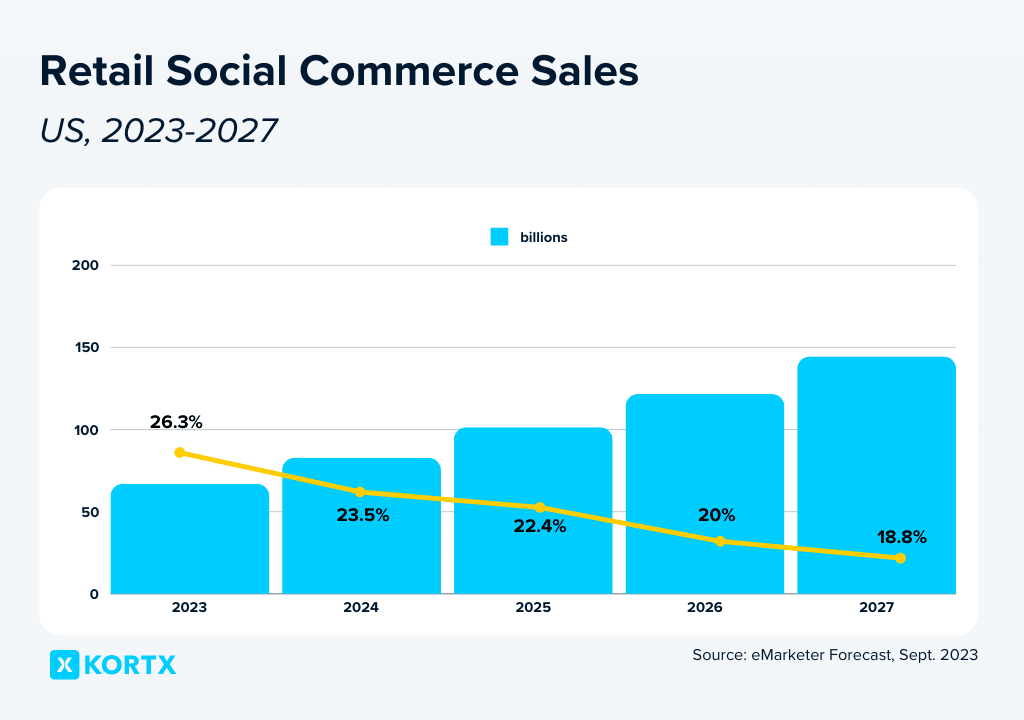
Platforms like TikTok and Instagram command the lead by blending ecommerce features like live shopping, in-app marketplaces, and logistics support, all driving up social commerce spending.
Trust remains a sticking point—about 31.8% of people prefer to keep shopping and social media separate. Concerns over data privacy and product quality hold some back.
Breaking through these trust barriers, especially regarding product quality and data security, is key to social commerce’s continued growth.
3 Facts That Prove Social Commerce is Growing
- Two-thirds of US social media users say they’re at least somewhat likely to research a product via social media before making a purchase.
- The average US buyer will spend $1,224 on social purchases annually, up 61.3% from 2024 and representing almost 10% of their annual ecommerce spending.
- 34% of holiday shoppers planned to use social media platforms to search for or purchase products.
Who’s Using Social Commerce?
Gen Z’s strong connection to social media has driven the rise of social commerce, turning it into a major channel for both their time and spending.
Where is Generation Z Shopping on Social?
68% shop on TikTok, 71% on Instagram, and 62% on Facebook.
But it’s not just about Gen Z. Over half of US shoppers aged 18 to 29 planned to use TikTok for holiday shopping, compared to 36% of adults.
For brands, it’s a chance to reach different age groups and connect with shoppers wherever they hang out online.
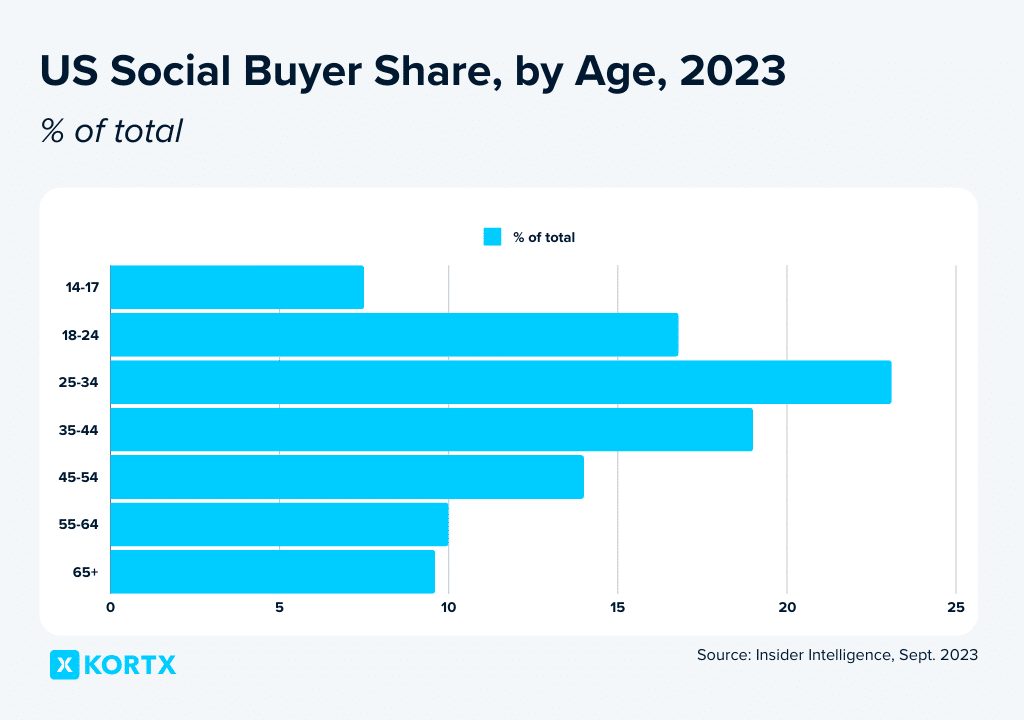
What Are the Benefits of Social Commerce?
Is adding a TikTok or Instagram shop to your strategy worth the investment?
Being on these platforms opens the door to a new kind of shopper and brings several advantages:
1. Social Commerce Drives Sales & Builds Loyalty
By 2025, social media will reach 4.4 billion users, giving businesses access to a massive, engaged audience. In the US, 110.4 million people already shop through these platforms. That’s half of all social media users.
At the awareness stage, social commerce is great for getting in front of new customers. Six in ten users discover new products on social platforms.
Retail strategies are shifting too, moving from just focusing on quick sales to building long-term loyalty. Marketers use social and CTV formats to reach a bigger audience and create lasting connections.
Social commerce supports every part of the sales funnel. Customers move from discovery to purchase, all in one place.
📚 Related article: Social Media Advertising: An Intro Guide & Tips
Learn more about paid social advertising, including why it helps you reach the desired audience organic social can’t.
2. User-Generated Content Builds Trust & Drives Product Discovery
User-generated content (UGC) is any content created by regular users—like photos, videos, or reviews—rather than by the brand.
UGC feels more genuine and relatable, giving shoppers a real look at other people’s experiences, which often builds more trust than company content. 70% of Gen Z and 68% of Millennials say UGC videos help them discover new products and services.
For example, seeing a customer share a photo of themselves wearing a particular clothing item on their Instagram feed can be more persuasive than a brand’s professionally styled photoshoot.
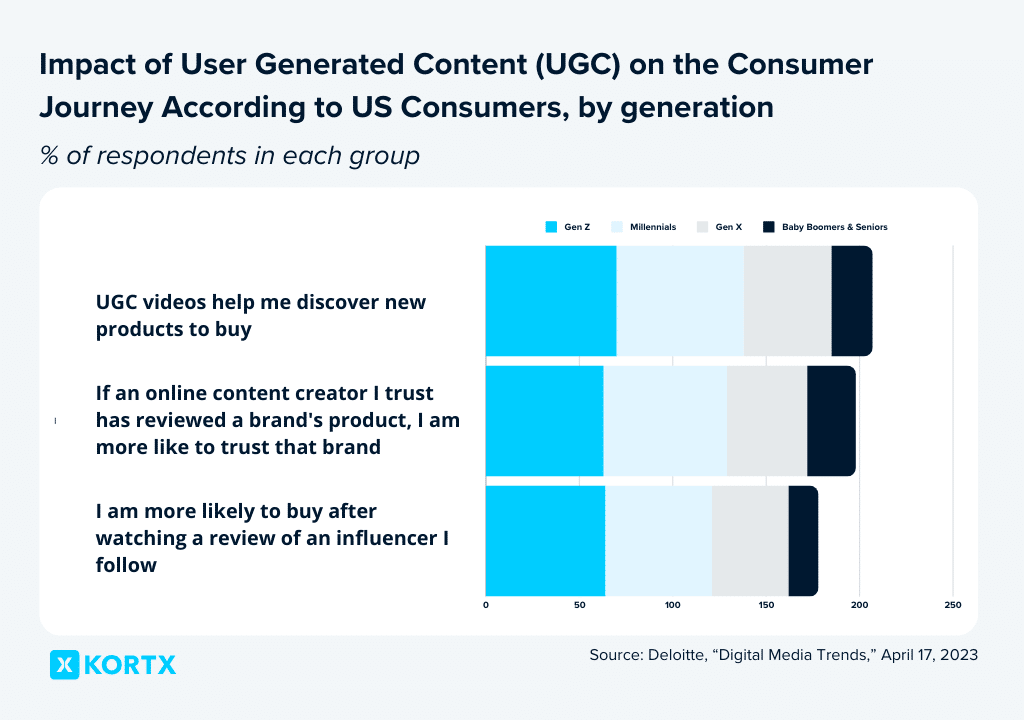
3. Social Checkouts Convert
When asked why they shop on social media, 31.9% of consumers cited convenience and familiarity as the top reasons, followed closely by 28.4% who valued the ability to buy products in real-time, just as they’ve captured their attention.
The simple, straightforward shopping experience that social commerce provides helps explain why it’s growing quickly.
4. Boost Sales on Social Media & In-Store
Some consumers remain cautious about social commerce, with nearly 4 in 10 concerned about how platforms manage personal data. Younger shoppers, especially those aged 16 to 24, prefer buying from established retailers rather than using in-app checkout tools.
However, social media still influences purchases, as 58% of US shoppers have bought a product after seeing it on a platform.
5. Increases Inventory Efficiency Through First-Party Social Commerce Metrics
All major social media platforms have impressive in-platform analytics capabilities. These First-Party data insights can help anticipate customers’ needs to encourage repeat purchases, drive loyalty, and adjust marketing strategies.
Brands can learn which products perform well, which can inform inventory decisions. This can personalize the customer experience as brands can keep the most well-loved products in stock.
For example, Shopify’s integration with Facebook and Instagram allows brands to monitor shop sales, purchases, product page views, and adds to cart, helping gauge customer interest and sales success.
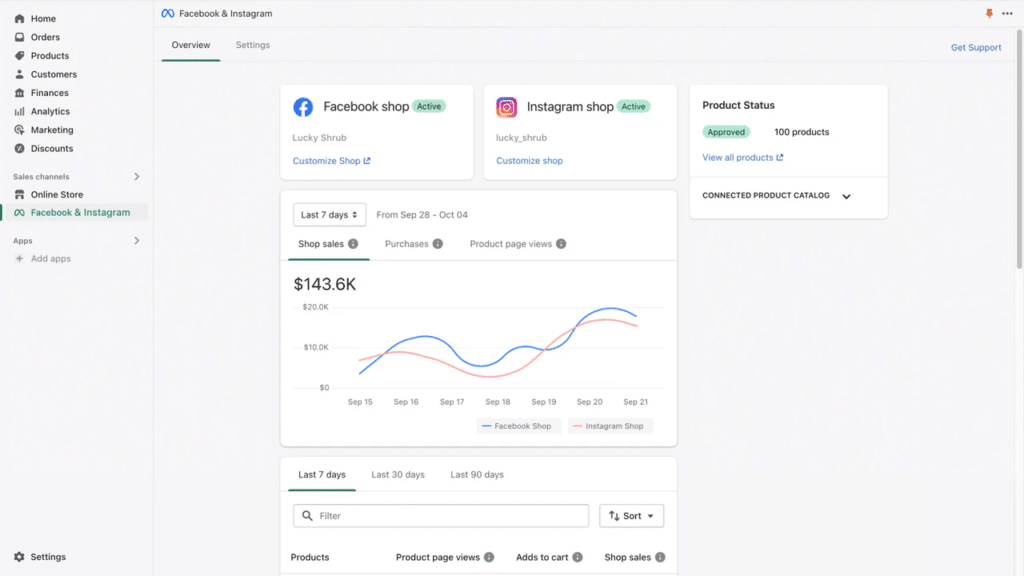
Top Social Commerce Platforms (2025)
Facebook, Instagram, and Pinterest pioneered native social commerce capabilities, followed by YouTube, TikTok, and others.
Explore the top platforms for social commerce marketing.
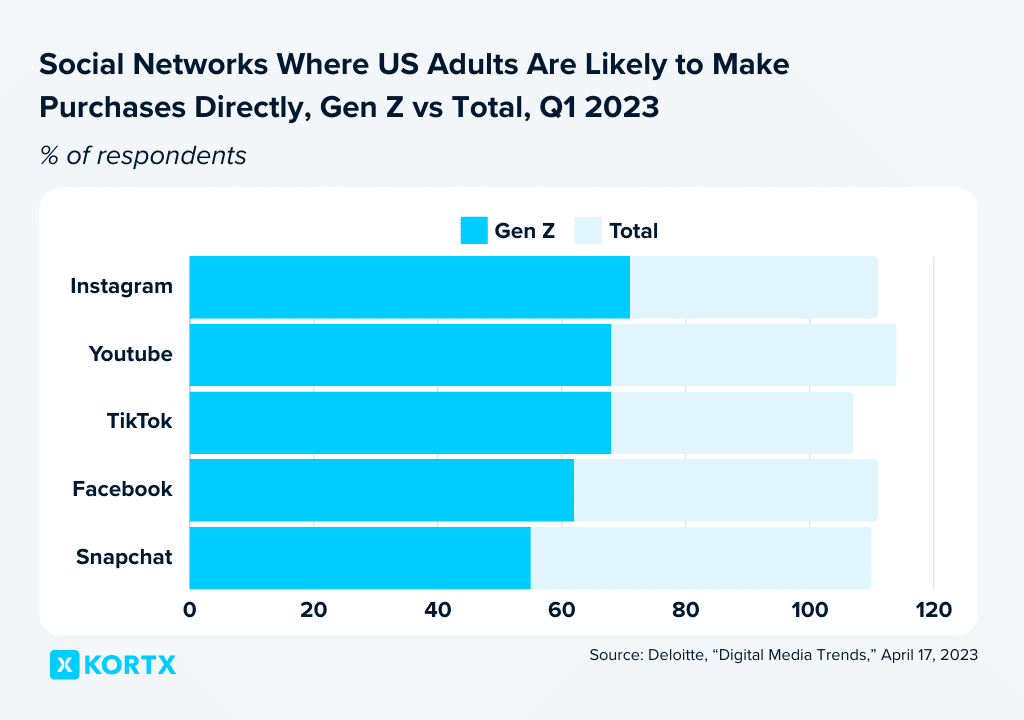
1. Facebook (Meta)
Facebook leads social commerce with its massive user base, allowing brands to reach a diverse global audience. Its extensive storefront features and insights make it a competitive platform for online shopping.
💡 Meta Made Mega Changes to Checkout
As of April 2024, Meta, Facebook, and Instagram’s parent company, required all US Meta Shops to use Checkout in-platform. Meta expects the move to drive adoption on Facebook and Instagram while limiting consumers’ ability to purchase on retailers’ websites.
Facebook Marketplace is a key driver, rooted in local, community-based listings for buying and selling secondhand items. Users can search for products and message marketplace sellers directly to negotiate prices or arrange transactions.
Facebook Messenger commerce allows users to shop directly within Messenger by chatting with brands, asking questions, and making purchases right in the chat.
Facebook Shops offers free digital storefronts where customers can browse and buy products without leaving the platform. Businesses can display detailed product catalogs, visuals, and descriptions, highlighting featured items, seasonal collections, promotions, and bundles.
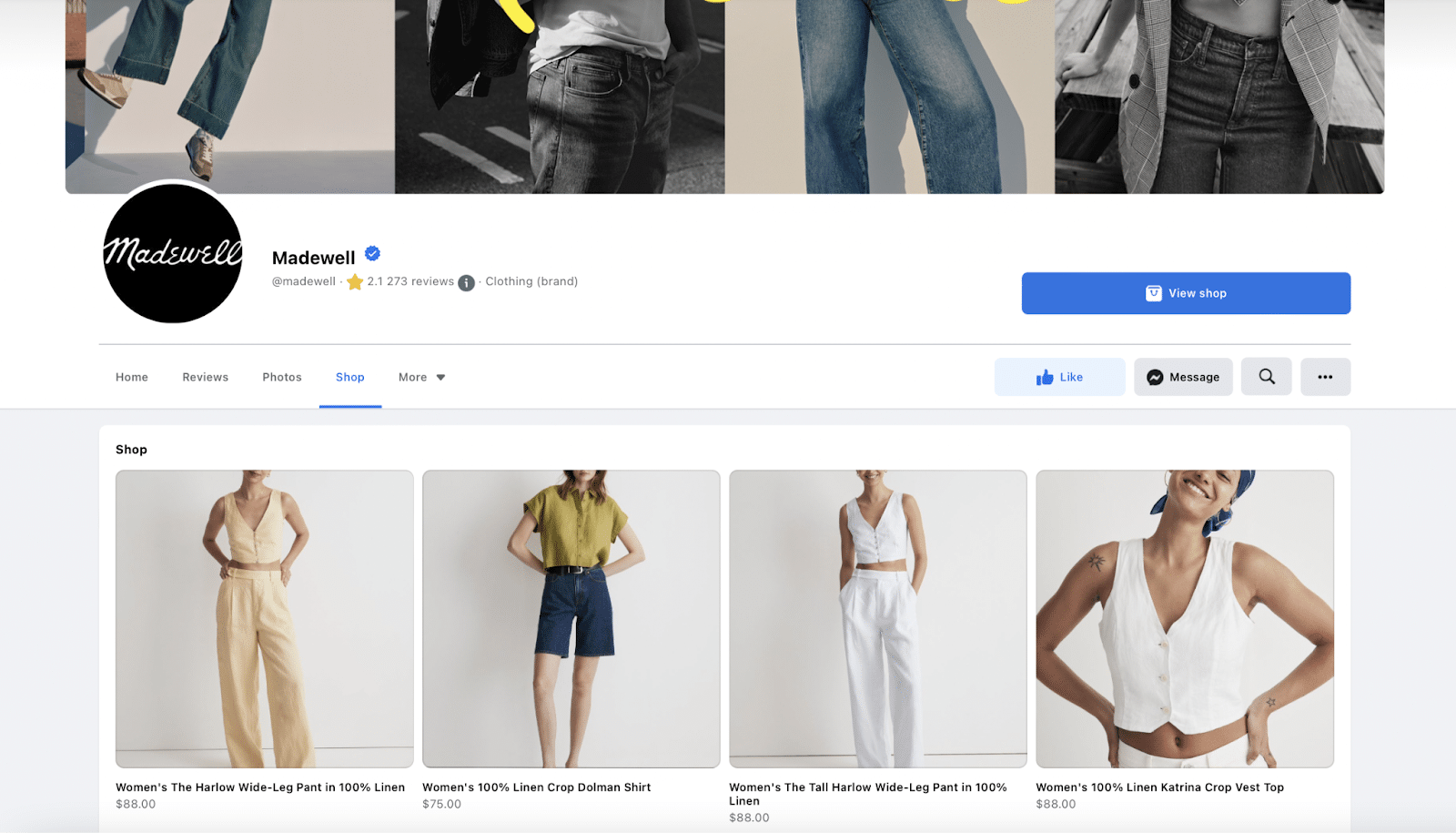
2. Instagram (Meta)
Instagram Shopping lets businesses tag products in posts and stories, allowing users to view details, prices, and purchase links with a click. Instagram includes features such as:
- Storefront Creation: Personalized storefronts accessible from profiles.
- Product Collections: Themed collections for easy browsing.
- Ads with Product Tags: Targeted ads featuring product tags.
- In-App Checkout: Seamless in-app purchases.
- Product Launch Reminders: Reminders for upcoming product releases.
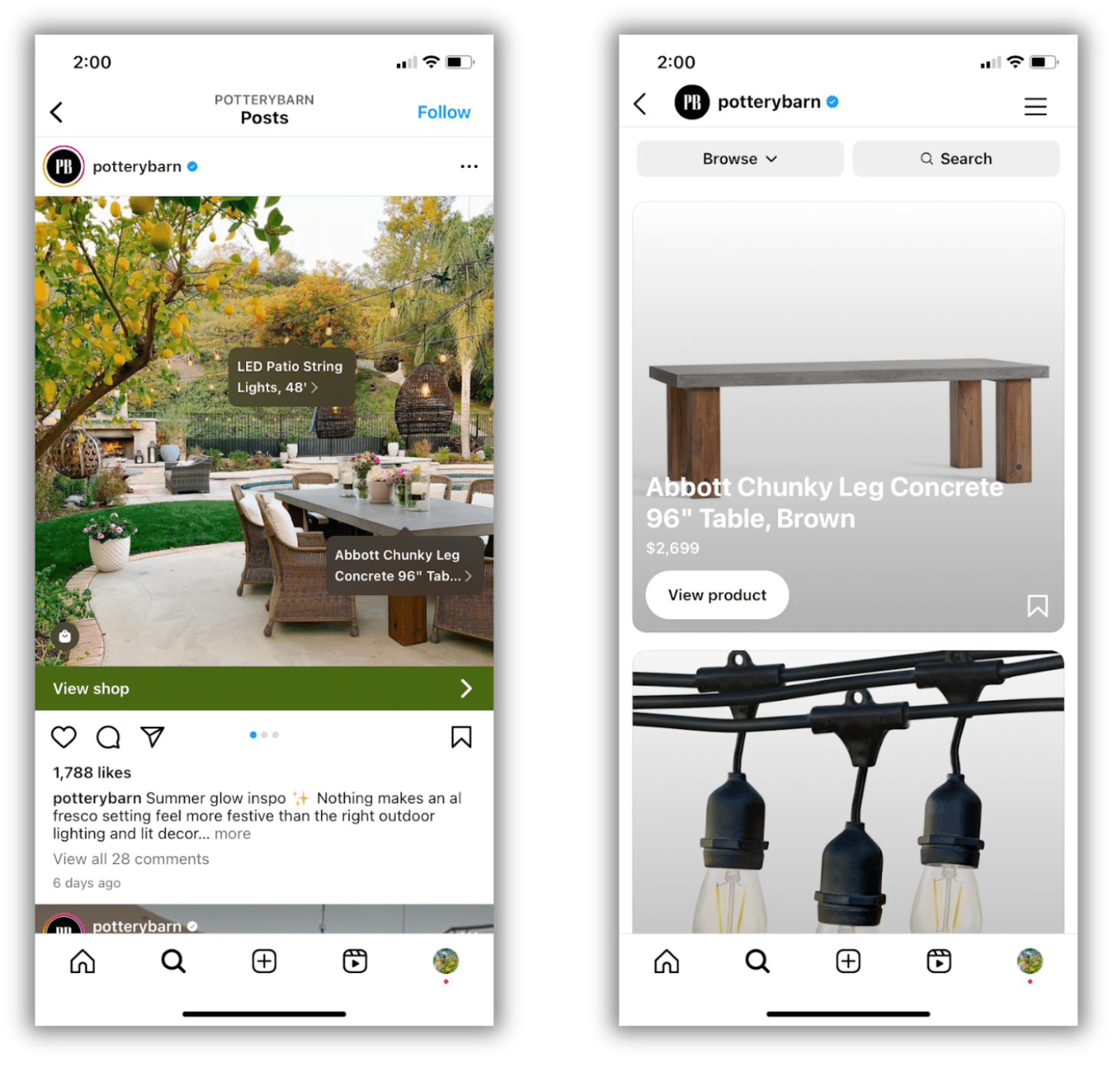
The “View shop” button allows users to explore your other listings, providing a seamless shopping experience.
3. TikTok Shop
TikTok has made monetizing easier for retailers by introducing social commerce capabilities.
TikTok Shop allows sellers to sell products directly on TikTok through in-feed videos, LIVE videos, and the Showcase tab.
Showcase is a feature that allows customers to shop directly from a seller’s or a creator’s account by displaying a shopping bag icon on the profile page of a TikTok account.
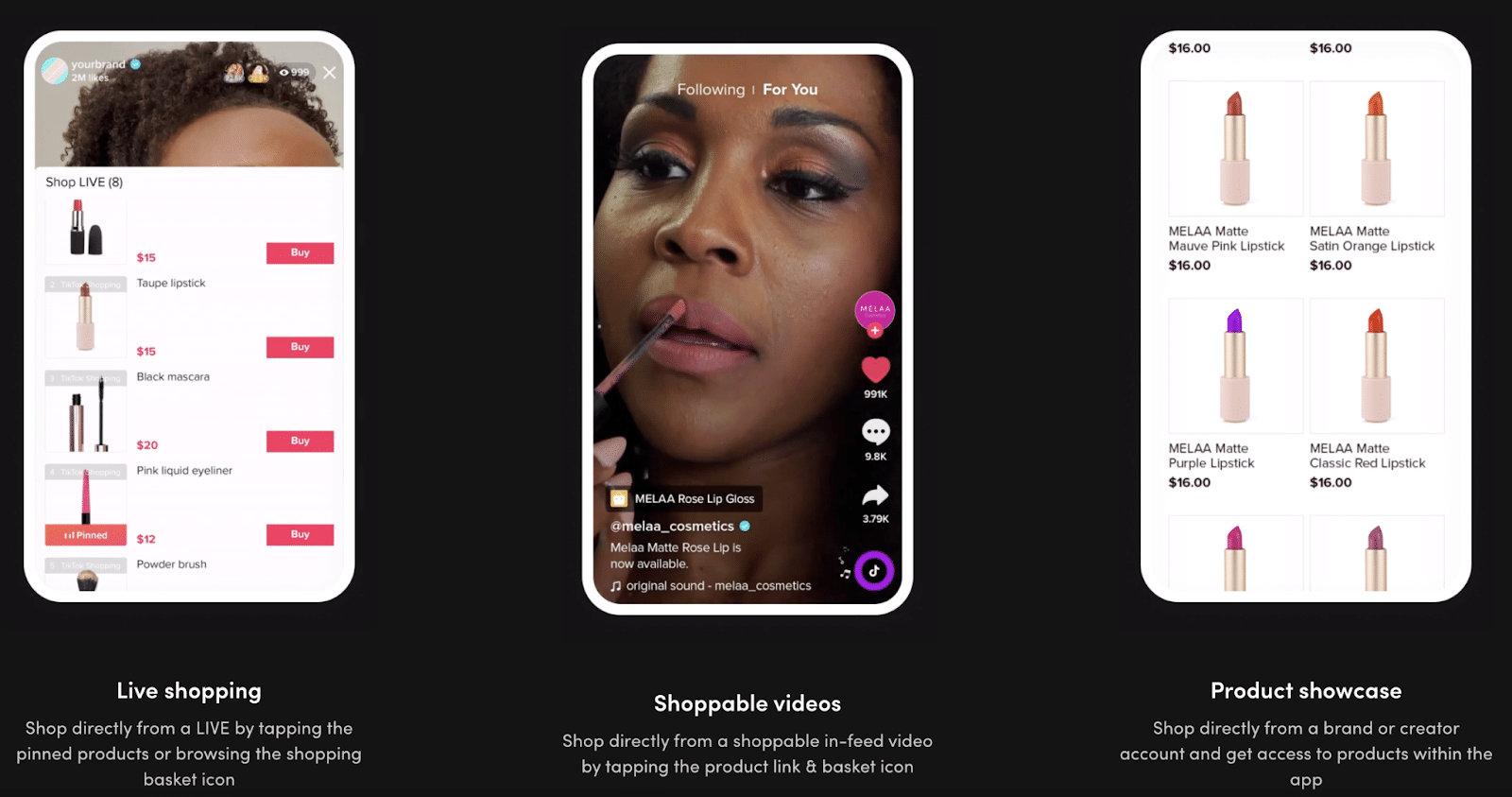
4. YouTube
YouTube Shopping lets eligible creators promote products from their own stores or other brands directly in their videos.
By connecting your store to YouTube, you can tag products in videos, Shorts, and live streams and showcase them in your channel’s store and product shelves. Viewers can easily browse and purchase through these features.
Performance analytics are available in YouTube Studio, and exclusive product listings can be offered to specific channels. Merchants handle all sales, fulfillment, and customer service.
5. Pinterest
Pinterest lets brands display their products with shoppable Pins. Users can check prices, availability, and details in one place.
Brands can upload their catalog to create Product Pins or use product-rich Pins that sync directly with their website.
Users share Product Pins organically, but you can only promote items from your catalog as shopping ads. Grouping products makes managing your catalog and improving your ad campaigns easier.
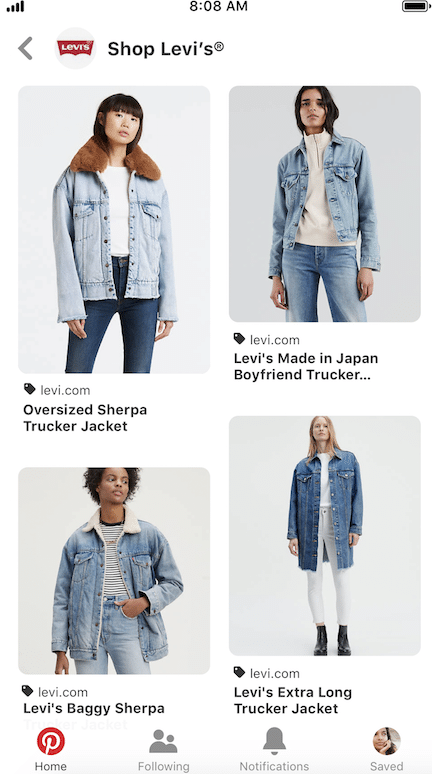
6. Snapchat & Other Notable Platforms
Snapchat may not be as big or feature-packed as other platforms, but it’s testing shoppable lenses and AR shopping experiences.
WhatsApp now has a business app with product catalogs and direct messaging, making it a solid tool for customer engagement and transactions.
WeChat takes it further, offering mini-programs that let users shop, pay, and connect with brands all within the app—making it a key player in social commerce, especially in China.
Amazon Live also deserves attention. It’s Amazon’s push into live-stream shopping, where brands can showcase products in real-time, interact with viewers, and drive instant sales—blurring the line between entertainment and ecommerce.
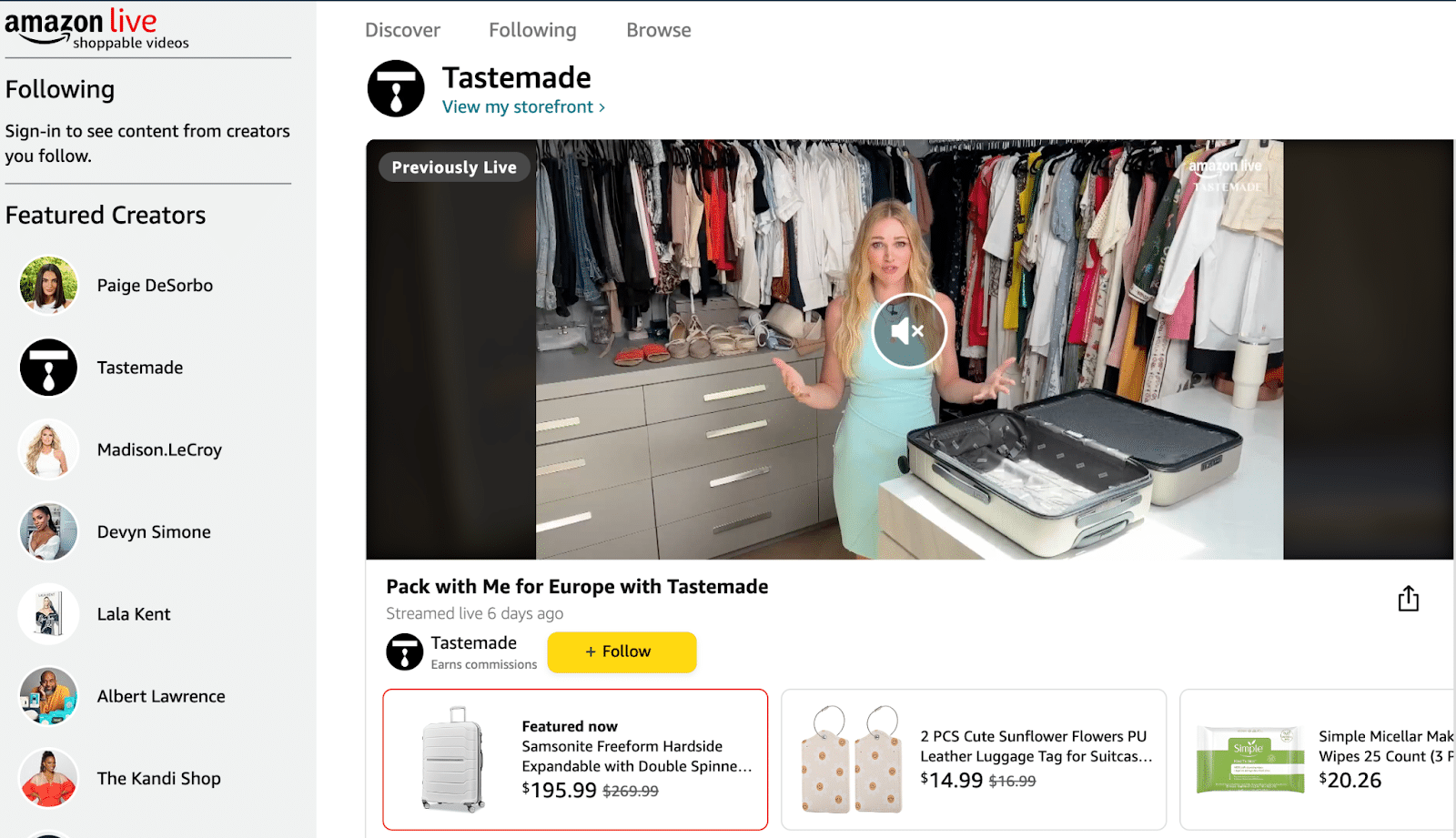
Social Commerce Strategies & Examples
Check out these social commerce strategies and examples to help guide and inspire your campaigns:
1. Go Omnichannel to boost sales.
A solid omnichannel approach is key. It drives 80% of in-store visits. Shoppers using multiple channels spend 4% more in-store and 10% online.
Omnichannel shoppers are also your most loyal. They visit stores 23% more often and keep coming back.
What’s an omnichannel retail strategy?
It’s about meeting your customers wherever they are, whether online, in-store, or on social media. The whole experience feels seamless.
📚 Read more: Omnichannel Retailing: How to Meet Your Customers’ Needs
Social commerce plays a significant role. When customers can buy right in the app, it creates a seamless, personal experience and increases the chances they’ll follow through.
But since some people are still iffy about buying through social media, offering other ways to buy can seal the deal.
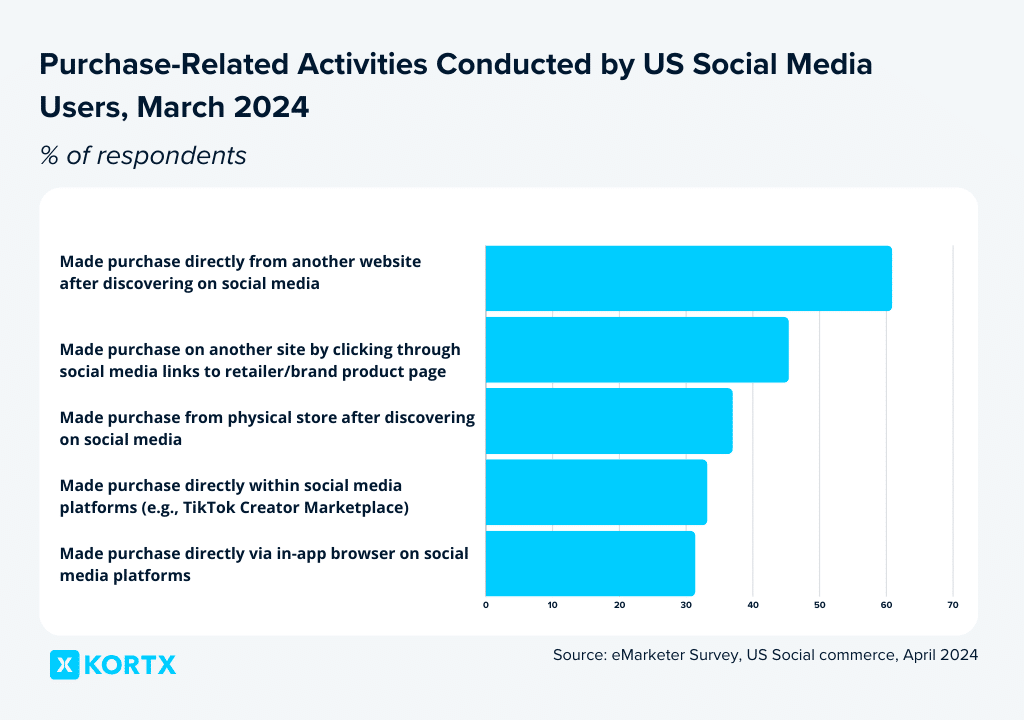
Example: Dollar Shave Club
Dollar Shave Club sells its products everywhere—from smaller businesses to big retailers like Target, their website, social media, and even through subscriptions. They also rely heavily on UGC, featuring tons of shoppable posts on TikTok, like this one:
@dollarshaveclub Come unbox the $5 Starter Set with us. #mensgrooming #shaving #routine
2. Incorporate a cross-device strategy to reinforce your brand’s memorability.
Most social media transactions still happen off-platform. Integrating social commerce with other cross-device targeting strategies, such as CTV, programmatic audio, display ads, and digital out-of-home (DOOH), boosts sales and brand awareness, reaching customers on any device.
Example: A user spots your product in a social media ad on their phone. They hear about it again in an audio ad during their commute. Then, they see it on a digital billboard later.
This consistent exposure across devices reinforces the brand message, increasing the likelihood of memorability and purchase.
Also, as mobile shopping grows, a smooth experience across devices helps capture sales from users switching between smartphones, tablets, and desktops.
Integrating cross-device strategies gives insights into how users interact with your brand across platforms, helping you optimize campaigns, allocate budgets, and refine messaging.
Example: NFM Cross-Device Targeting Yields 9.8X ROAS
KORTX used its Device Graph for cross-device targeting, syncing messages across all devices for an NFM ecommerce campaign. By combining OLV and CTV placements, we created a personalized ad experience. This drove 68,402 cross-device site activities and 54% desktop conversions after mobile interaction, boosting purchase revenue by 18.6%.

3. Retarget social users who indicated interest.
A comprehensive retargeting strategy combines various digital touchpoints to create a cohesive approach. Whether through social media, CTV, or other digital channels, the goal is to re-engage users who have already expressed interest in your brand.
You can retarget for social commerce using various strategies, including:
- Social Media Ad Retargeting: Social media platforms let you retarget users who interacted with your content or visited your site. Tailored ads reminding them of viewed or carted items can boost conversions and keep your brand top-of-mind.
- CTV Retargeting: CTV retargeting delivers personalized ads on streaming platforms, targeting users who’ve shown online interest. This approach reinforces your message in an immersive setting.
- Cross-Device Retargeting: Cross-device retargeting allows your ads to follow users across devices This maintains consistent messaging and guides them through the purchase journey on any device.
Example: Mountain Dew’s Sweepstakes

KORTX used TikTok and custom rich media ads to engage new fan groups with 15- and 30-second videos to promote the “Green Means Go” sweepstakes. KORTX retargeted visitors on social media who interacted with the campaign landing page but didn’t complete their entries.
This resulted in over 18,500 sweepstakes entries and the collection of 163,000 unique events.
📚 Read more of the case study here: Mountain Dew TikTok Sweepstakes
4. Go beyond simple audience demographics to find users with purchase intent.
Use advanced audience segmentation to spot users with purchase intent on social commerce platforms. This helps you target those most likely to buy, optimizing your budget and boosting conversion rates.
Analyzing user behavior—like click-through rates and in-platform purchase conversions—reveals which products and channels work best for specific demographics.
For brands that want to dig deeper, detailed insights and research are crucial for understanding performance. They help you track progress, compare results, and see how you measure up to industry standards.
Example: Meta’s Facebook Audience Insights for Social Media Ads
Meta’s Facebook Audience Insights provides comprehensive targeting options, including audiences and targeting criteria.
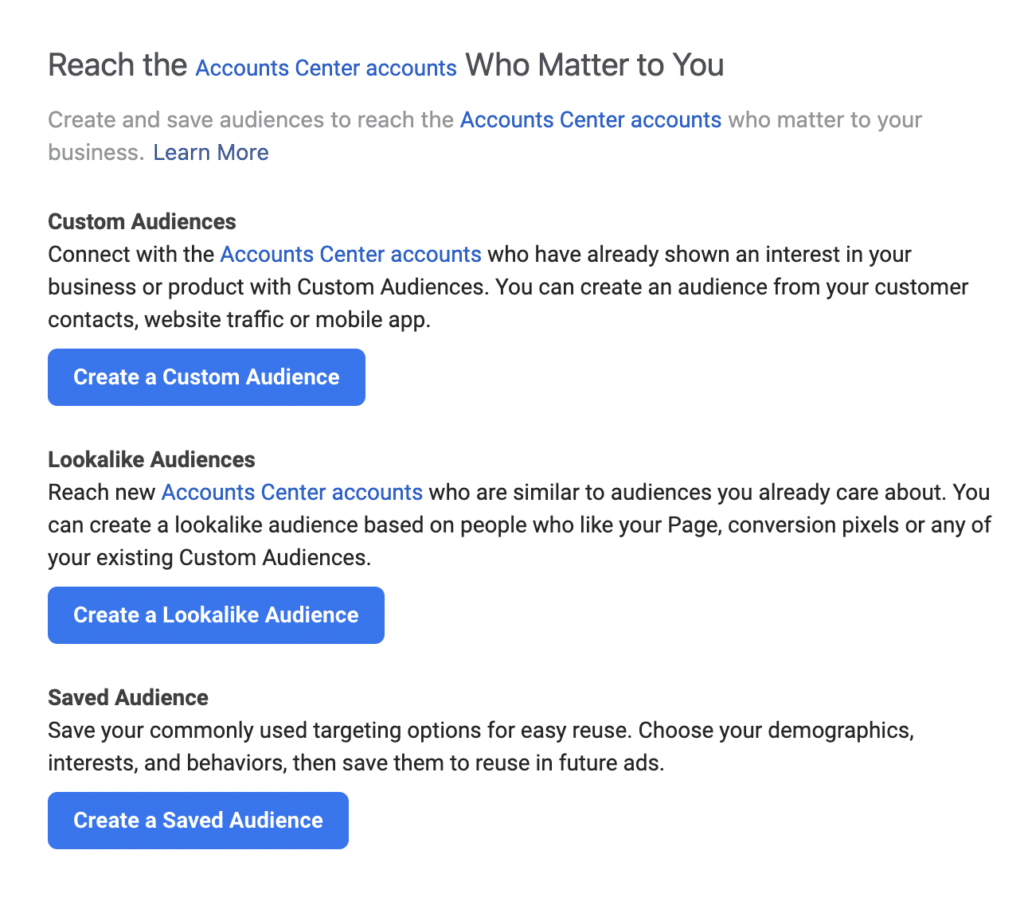
Set up Custom Audiences from your First-Party data, Lookalike Audiences that resemble your targets, and Saved Audiences for future use. Target users by location, age, gender, language, and other detailed factors, including demographics and interests.
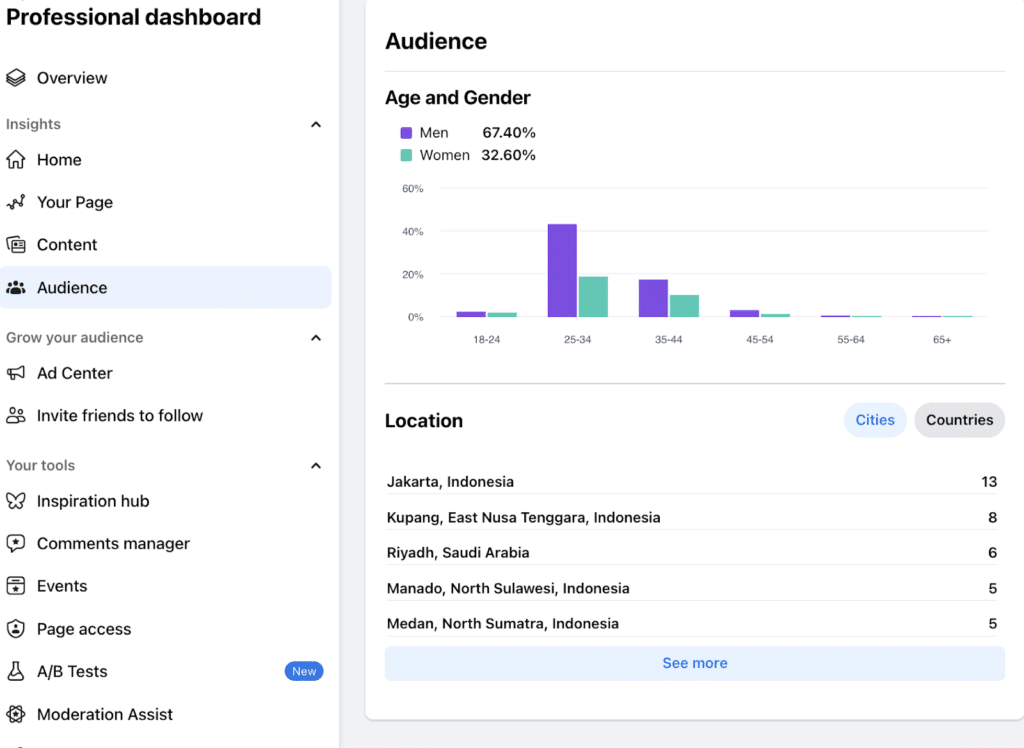
5. Incorporate personalization to meet & exceed customer expectations.
Customers now expect a personalized experience —71% say it’s a must, and 76% get frustrated when it’s missing.
To keep up, offer tailored product recommendations based on what users have browsed or bought before.
Retargeting can remind users of products they’ve shown interest in across platforms. For example, you can retarget with display ads with the exact items they viewed or add to their cart and suggest related products.
Example: Cadbury’s Glow Campaign Saw 90% VCR
Cadbury’s Glow campaign tackled the challenge of chocolate not being a go-to gift in India. They launched a social video campaign where users could create personalized videos using photos and names from their Facebook profiles.
When the recipient got a box of Cadbury Glow chocolate, they accessed the video via QR code or by entering their number on the Cadbury site. This personalization strategy led to a 90% VCR, 65% CTR, and a 22% conversion rate.
6. Adopt new payment methods for more sales.
Limited payment method acceptance in social commerce could be deterring potential buyers. While buy now, pay later (BNPL) services are used by 11% of US digital buyers, only 4% use them for social commerce purchases. This discrepancy is likely due to limited acceptance rather than consumer reluctance.
PayPal leads for social commerce digital wallets. Over 39% of buyers used PayPal for social media purchases in the past year. Debit and credit cards are also popular, with debit cards leading and credit cards following closely behind.
Gen Zers, major social media users, strongly prefer Apple Pay. 34.2% of Gen Z social commerce buyers used Apple Pay in the past year—more than double the overall user rate of 16.4%.
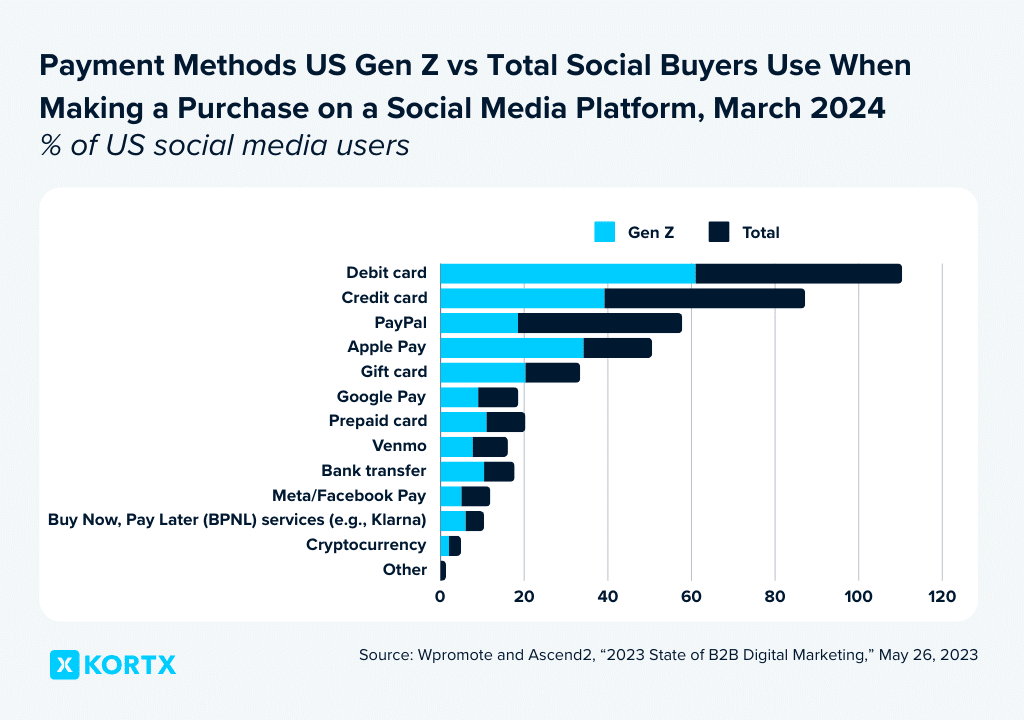
Expanding payment flexibility, including options like Apple Pay, will enhance customer satisfaction and increase conversion rates by making purchasing more convenient and aligned with buyers’ preferences.
Example: Affirm: Flexible Payment Options


Affirm, a buy now, pay later provider for online and in-store purchases, offers this example of how a brand can showcase its flexible payment options through various social media assets, such as an Instagram post or a story.
📚 Other expert articles on digital retail marketing:
- Retail Digital Marketing: What It Is, Types & Strategies: Get into what retail marketing really means, the key trends, and the types driving the industry forward.
- Omnichannel Retailing: How to Meet Your Customers’ Needs: Discover how omnichannel strategies can increase conversions and improve customer retention.
- The Top 9 Digital Retail Trends in 2024: Check out the top retail trends shaping the industry this year.
7. Host live online & in-person shopping events to connect with customers.
Host live shopping events—either online or in-person—with influencers or brand ambassadors to engage directly with your audience and drive sales. Live shopping, especially big on TikTok, combines real-time interaction with easy in-app purchases.
Interest in live shopping is growing in the US, with 75% of people wanting more, though only 7% use it regularly. It’s still early days, but the demand is apparent.
Brands that jump in now and refine their approach—whether through influencers or in-person events—can grab attention and drive sales as the trend grows. Fashion, beauty, and tech brands will likely benefit most, where real-time interaction can quickly sway buying decisions.
Example: Pinterest Predicts

Pinterest Predicts’ December 2023 pop-up in New York City allowed users to experience anticipated trends firsthand, inspiring and enabling them to shop in person.
Pinterest set up shop window-style displays featuring products, each with a QR code. Shoppers scanned the code with their phones or used the Pinterest Lens to open the item in the app and make a purchase.
8. Consider retailer distribution and partnership to reach an even wider audience.
Larger retailers are increasingly partnering with streaming platforms to enhance their social commerce strategies and reach new audiences.
Example: Walmart’s “Add to Heart”

Last year, Walmart debuted its holiday-themed romantic comedy, “Add to Heart.” This shoppable video series is available on Roku, TikTok, and YouTube. With 23 episodes and 330 shoppable products woven into the storyline, it offers viewers a unique and immersive shopping experience.
9. Use A/B testing to refine your social commerce strategies.
A/B testing helps you determine what works best by testing different ad elements—like visuals, product placement, and messaging. It gives you accurate data to see what clicks with your audience.
For example, test different Facebook ads to see if a photo or a video drives more engagement.
You can experiment with product names, descriptions, and button texts to see which options lead to more conversions.

Test various product names, descriptions, and button texts for your social commerce store to determine which combinations lead to higher conversion rates.
A/B testing analytics help you make informed decisions and fine-tune your social commerce campaigns.
How should brands use creative A/B testing to boost their social commerce success?
“A/B testing for ad creatives gives you real data to see exactly what’s working and what’s not. Small tweaks—like a different image, headline, or even a button color—can lead to huge gains in engagement and conversions. Without testing, you’re just guessing. With it, you’re constantly refining and improving your strategy.”
How to Measure an Accurate Social Commerce ROI
Measuring social commerce success is critical to optimizing campaigns and understanding ROI. Focus on these areas:
- Engagement Metrics: Track likes, shares, comments, and video views to gauge content resonance and interaction. Monitor shoppable post performance and hashtag success to see what drives engagement.
- Conversion Metrics: Measure conversion rates by analyzing click-throughs on shoppable posts and tracking completed purchases within the app or your website. Use UTM parameters to refine strategies based on sales data.
- Customer Journey: Analyze how users move from product discovery to purchase, noting whether they complete purchases in-app or on the website. Social commerce often shortens the journey, boosting impulse buys.
- Social Proof: Monitor user-generated content (UGC), like reviews and testimonials. Positive UGC acts as social proof, influencing purchase decisions. Encourage customers to share experiences using branded hashtags, so you can track these.
- Sales Data: Track revenue from shoppable posts, live streams, and in-app storefronts to see the direct impact of social commerce on sales.
By monitoring these metrics, brands can optimize social retail strategies and drive business results, though attributing sales solely to social media can be challenging within a broader omnichannel approach.
Start With a Social Commerce Strategy
Social commerce is changing how we shop, and it’s here to stay.
To make the most of it, start with a solid audience understanding, clear goals, and the right platforms to nail social commerce. Experiment with content, track the outcomes and tweak things as needed.
Turn Likes Into Add to Carts 💰
Your audience is waiting. KORTX will help you connect and convert with precise, data-driven social media strategies so that every ad dollar counts.
About the Author
Josh Pheneger is an Account Manager at KORTX. He likes to play golf, explore the city, and spend time in coffee shops.

